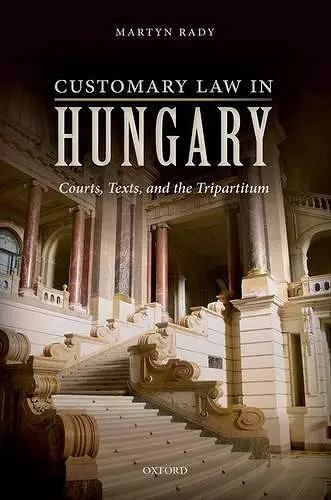Customary Law in Hungary
Courts, Texts, and the Tripartitum
Format:Hardback
Publisher:Oxford University Press
Published:6th Aug '15
Currently unavailable, and unfortunately no date known when it will be back

This is the first comprehensive treatment in any language of the history of customary law in Hungary, from the thirteenth to the twentieth centuries. Hungary's customary law was described by Stephen Werboczy in 1517 in the extensive law code known as the Tripartitum. As Werboczy explained, Hungarian law derived from the interplay of Romano-canonical law, statute, written instruments, and court judgments. It was also responsive, however, to popular conceptions of the law's content and application, as communicated through the lay membership of the kingdom's courts. Publication of the Tripartitum was intended to make the law more certain by fixing it in writing. Nevertheless, its text was customized by actual use, in the same way as the statute laws of the kingdom were adjusted as a consequence of court practice and of errors in their transmission. The reputation attaching to the Tripartitum and Hungary's insulation from the Roman Law Reception meant that the Tripartitum continued to retain authority until well into the nineteenth century. Attempts to replace it foundered and it was the principal text on which the courts and the schools relied, not only in Habsburg Hungary but also in Transylvania. Courts, nevertheless, continued to modify its provisions in the interests of rendering judgments that they deemed either to be right or in conformity with developing practices. Even after the establishment of a parliamentary form of government in the nineteenth century, a strong customary element attached to Hungarian law, which was amplified by the association of customary law with national traditions. The consequence was that Hungary maintained aspects of a customary law regime until the Communist period.
Martyn Rady's monograph is a remarkable overview about a large part of Hungarian legal history. Not only does it provide an insight into the history of sources and judicial organization, but it also demonstrates the essence and development of many important legal institutions in the field of private law, criminal law, procedural law and constitutional law. * Laszlo Komaromi, Parliaments, Estates & Representation *
This book benefits from Radys extensive knowledge not only on the Hungarian and Latin languages but also his commitment to central European history and his long-standing research interests into customary law. ... Not only is it a welcomed addition to the scholarship of Hungarian, but also legal, feudal and central European histories. * Matthew Martin, SLOVO *
ISBN: 9780198743910
Dimensions: 240mm x 175mm x 25mm
Weight: 578g
280 pages